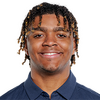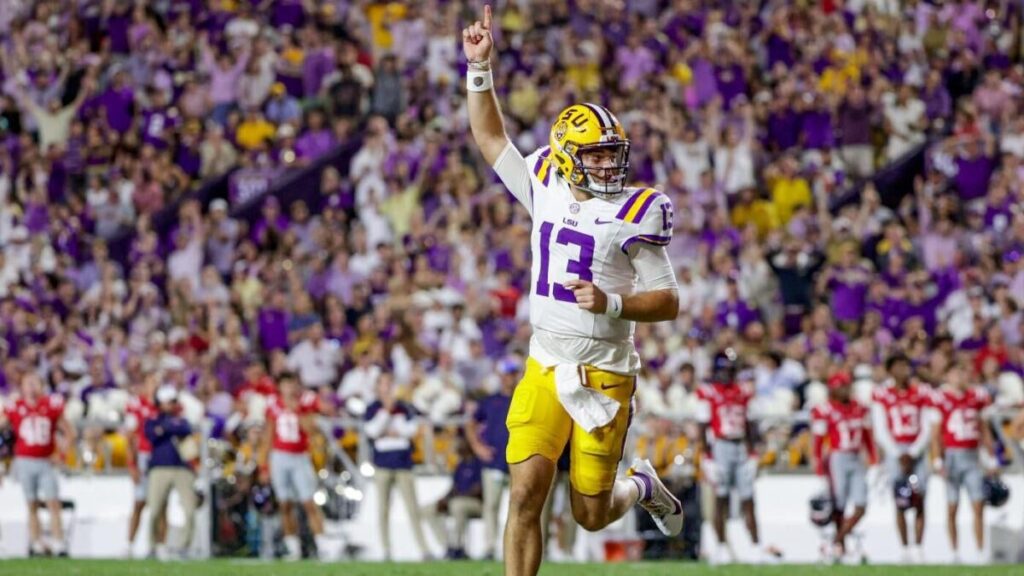Twelve months ago, quarterback Cameron Ward was No. 24 on my top 50 big board. By late April, he was the first-overall pick. It was the seventh time in the last eight drafts (and nine of the last 11) that a quarterback has been selected No. 1.
The lesson: there’s a lot we don’t know as the college football season gets underway, and much will change between now and the 2026 NFL Draft. Ward, for example, was considered an early Day 3 prospect during his 2023 season. He then transferred from Washington State to Miami, had a fantastic 2024 campaign and ended up going first overall to the Titans.
This is my annual preseason top 50 Big Board. I like to think of it more as a starting point on a road map that ends 239 days from now in Pittsburgh at the 2026 NFL Draft. And if you missed it, former Titans general manager Ran Carthon and I talked about many of these players exhaustively during our “Summer Scouting” series on “With the First Pick,” our year-round NFL Draft podcast.
Seven quarterbacks made my preseason big board from last year:
This list is instructive for a few reasons. First, preseason lists rely heavily on projections; NFL teams were high on Beck and Weigman, but both players struggled for parts of the 2024 season and wisely returned to school. Meanwhile, Ward made some big developmental steps in 2024 and cleaned up some of the reckless play that concerned teams. Allar and Nussmeier both looked like first-round talents at times last season, but the lack of consistency wisely led them to return to school. You’ll again find their names below.
All told, just four quarterbacks cracked my preseason top 50 this year. And that brings me to Arch Manning. Before you get angry, I’ll explain why he’s not No. 1 on my big board, but you’ll have to scroll down a bit to find it. All the way to No. 9, in fact. Again, this may make you very mad. I’d encourage you to read my thoughts, and if you’re still fired up, that’s fine. If you can see where I’m coming from, that’s fine, too. Either way, football is supposed to be fun, and life is way too short to let what someone says on the internet about a player you’ll likely never meet ruin your day.
Alright, let’s get to it.
Note: ⭐️ represents each player’s 247Sports star rating as a high school recruit

Just 20 years old, it feels like Woods is just scratching the surface. He consistently plays with low pad level, leverage and power, lines up anywhere along the defensive line, and is just as disruptive on the interior as he is when Clemson lines him up over or outside the tackle. I posed this question to Carthon during our “Summer Scouting” series: “Mason Graham (fifth overall), Kenneth Grant (13th) and Walter Nolen (16th) were the first three defensive linemen off the board in April. Where are you taking Woods among that group?” Carthon’s response: “First.”
You have to go back to 1994 to find the last time an interior defensive linemen was drafted first overall – the Bengals took Dan Wilkerson – and given the importance of the quarterback position, I don’t see that changing this year (especially if that University of Texas quarterback defies history and conventional wisdom and declares for the 2026 draft). That said, whichever team lands Woods, whether it’s No. 2 or No. 6, will be getting a first-overall-pick type of talent.


Unofficially 6-foot-7 and 360 pounds, my summer comp for Proctor was JC Latham but two inches taller and 20 pounds heavier. He has an enormous frame, is incredibly athletic for his size and plays with overwhelming-at-times power in both the run game and pass protection. Latham was the No. 7 pick in the 2024 NFL Draft; Proctor could go higher than that in 2026.


I first watched Faulk in May, and I thought he was good, but didn’t love his tape. Then I revisited him again in July, before former NFL defensive linemen and my CBS Sports colleague Leger Douzable talked about the edge rushers in our “Summer Scouting” series.
Let me just say it felt like I was watching a completely different player. (And that was more about me than Faulk; anyone who has evaluated players has had this experience — you love a player upon first viewing but when you come back to him, it’s something less than what you originally thought. Or the opposite happens, and it can be due to any number of factors: your mood, the games you’ve chosen to watch, whether you got a bad night’s sleep, etc.)
First, Faulk won’t be 20 years old until September. Second, he’s unofficially 6-foot-6 and 288 pounds, and he is already near-elite as a run defender. The power and athleticism with which he plays makes it an easy projection to see him as a dominant pass rusher down the road. Maybe it doesn’t happen this season, and maybe it doesn’t happen until, say, Year 2 in the league, but when it all comes together, it’s going to be scary.


“Clinical” is the first word that comes to mind when describing Fano’s playing style. He’s not the biggest offensive linemen in the class, and the edge with which he plays reminds me of 2024 first-rounder, Troy Fautanu. Like Fautanu, Fano played left tackle before moving to the right side last season where he was, well, clinical. At 6-foot-5 and 304 pounds (unofficially), he’s lithe, at least by behemoth offensive line standards. It’s why he’s such a great fit in zone schemes; his lateral movements are exceptional and he has the perfect blend of athleticism and power. He’s a technician vs. the run and in pass protection.


I’m higher on Lomu than other folks in the media and that’s OK. One of the reasons for a preseason big board is to project players who have the physical tools and have perhaps flashed the ability, just not consistently, to make a 2 to 3 round jump from August to late April. He played just 25 offensive snaps in 2023 but was the starting left tackle a season ago. Not only did he play with good balance and surprising power, but his length and athleticism were all over the tape both as a run blocker and in pass protection.


A year ago, Malaki Starks was my No. 1 safety and 20th on my preseason big board. Starks has been as good (and maybe even better) than advertised for the Ravens during the preseason, but Downs could be a Troy Polamalu-level talent in the NFL. He’s only 5-foot-11, and he may not end up running a 4.35-second 40-yard dash, but I don’t care. Not even a little bit. Both Kyle Hamilton and Brian Branch slipped on draft day because of mediocre 40 times. They’re two of the best young defensive backs in football. Downs is a run-game enforcer and has the sideline-to-sideline juice, coupled with the short-area burst, to excel in pass coverage.


A road-grader and earth-mover in the run game, Mauigoa engulfs defensive ends. And for his size (unofficially 6-foot-6 and 329 pounds), he flashes insane athleticism. Right now, he’s a better run blocker than pass protector, and he’s played just right tackle at Miami, but he’s a first-round talent who should only get better in 2025.


Parker plays with one of the highest motors in this class, and on the field, his hair-on-fire approach to rushing the passer, along with his long frame, reminds me of James Pearce Jr., who was a Falcons first-round pick this spring. Parker can win with both speed and power, he is consistently stout at the point of attack, he flashes high-end athletic traits, and he’s just going into Year 3 at Clemson. If you have just two words to describe Parker, it would be “consistently disruptive.”
9. Arch Manning, QB, Texas


OK, let’s have the Arch conversation. He played in two games last season against middling competition. He threw two interceptions against Louisiana Monroe in his first extended action, and the next week, he was really good against Mississippi State.
But if his name was, say, Archibald Manningham, and the physical tools, the mental makeup — everything other than being born a Manning — were the same, we’d be talking about him as a tools-y Day 2 prospect, maybe even a late Day 1 talent as we sit here. I know, it’s hard to suss out the part about him being a Manning.
In some ways, it’s the exaggerated version of Drake Maye from two years ago — a tools-y high-round talent who grew up in a family full of competitors and winners. And that separated him from other talented players who didn’t have the benefit, or the exposure, of being around high-achieving, laser-focused athletes his entire life.
But maybe that’s overthinking it. Put another way: I love Manning’s game and I’d be perfectly content to put him No. 1 here based mostly on pedigree but also those handful of snaps from last season. Plus, history tells us he probably won’t leave school for the draft after the season.
And if that’s the case, I’d rather not spend time talking about Manning over the next five months only for him to announce he’s headed back to Austin for the 2026 season. Would he be QB1 in this class were he to come out? Of course. Would he be the first player drafted if the draft were held tomorrow? Yeah, almost certainly.
But for my preseason big board, I worked from the premise that he’s probably not coming out. I’m trying to treat him like a typical high-upside redshirt sophomore who, despite limited reps, looks like a future face of the franchise if everything falls into place … even if we all know Arch is anything but typical when it comes to his past, present and soon-to-be future.


One of my favorite players in this class, Williams was targeted 109 times last season and hauled in 11 touchdowns. He did have eight drops — most of them focus drops — but that will have to be cleaned up.
At 5-foot-10, 195 pounds. (unofficially), Williams isn’t a big target but plays much bigger than his measurables. He splits his time between the slot and outside, has the ability to consistently get to the corner on jet sweeps, has an extra gear in the open field and has the short-area quickness to make would-be tacklers look silly. Williams can win off the line of scrimmage vs. press coverage, consistently stacks defensive backs on downfield routes and tracks the ball well in the air.
No. 10 feels high because of his measurables, and I get that, but in recent years we’ve seen similarly sized names like Matthew Golden, Xavier Worthy, Zay Flowers, Jordan Addison and Jaylen Waddle all go in the first round.
11. Garrett Nussmeier, QB, LSU
12. Rueben Bain Jr., EDGE, Miami
13. Tyreak Sapp, EDGE, Florida
14. LT Overton, EDGE, Alabama
15. Fernando Mendoza, QB, Indiana
16. CJ Allen, LB, Georgia
17. Drew Allar, QB, Penn State
18. R Mason Thomas, EDGE, Oklahoma
19. Xavier Chaplin, OT, Auburn
20. Jeremiyah Love, RB, Notre Dame
We spent a lot of time on the podcast last fall talking about Nussmeier’s potential. He got off to a good start in 2024, regressed down the stretch enough to make me joke that my comp for him was somewhere between the LSU version of Joe Burrow and the Jacksonville Jaguars version of Mac Jones — you just never knew which player you were going to get. Put another way: Nussmeier was smart to return to school for another season. He’ll have plenty of weapons around him and every opportunity to be in the QB1 discussion in a world that doesn’t include Arch.
Meanwhile, fewer players gave me more enjoyment during summer scouting than Mendoza. He played much of the season under duress because Cal’s line was, shall we say, not great. And while he often played with pressure in his face, he consistently stood tall in the pocket and delivered strikes to all three levels on time and accurately. It’s why I have him ranked ahead of Drew Allar, and I won’t be shocked if Mendoza takes his game to another level at Indiana.
Allar looks the part, but he hasn’t yet put it all together. We’ve seen flashes — perhaps more from him than other QBs on this list — but we’ve also seen the decisions that give us enough pause to reconsider the idea of making him a top 15 selection. He can answer a lot of those questions this fall because he has the size, arm strength and athleticism to be a franchise QB; he just has to show he can put it all together.
One other name — a non-quarterback — that I wanted to mention here: R Mason Thomas. He’s just 6-foot-1 ½ and weighs 249 pounds, so he doesn’t have the prototypical height and weight of a high-end NFL edge rusher. Donovan Ezeiruaku and Nik Bonitto were both under 250 pounds. and 6-foot-3 or shorter, both were second-round picks, and both, it turns out, are the closest comps I have for Thomas. In fact, I think he’s better vs. the run and he might be more explosive as a pass rusher. Thomas can win with speed or power, plays with a high motor and has sideline-to-sideline juice. He might be a designated pass rusher early in his NFL career, but he can develop into an all-around playmaker.
21. Avieon Terrell, CB, Clemson
22. Isaiah World, OT, Oregon
23. Jordyn Tyson, WR, Arizona State
24. Jermod McCoy, CB, Tennessee
25. A.J. Harris, CB, Penn State
26. Austin Barber, OT, Florida
27. Caleb Banks, DL, Florida
28. Suntarine Perkins, EDGE, Ole Miss
29. Harold Perkins Jr., LB, LSU
30. Aaron Anderson, WR, LSU
Tyson is a big-bodied receiver who can effortlessly snatch the ball out of the air and then immediately becomes a legit YAC machine. He has an enormous catch radius, routinely making tough catches look routine. He can have the occasional focus drop, and I would like to see him stack defensive backs more consistently on vertical routes. That said, he has the contested-catch and high-point skills that will immediately translate to the next level.
McCoy just turned 20 years old and could end up easily going 10 to 15 picks higher than where I have him ranked here. He suffered an ACL injury in January but had four interceptions and 13 pass breakups a season ago, and at 6-foot and 193 pounds, he can match up physically with most NFL WRs. He excels in both man and zone schemes, is consistently in phase on downfield routes and is looking to thump someone when coming downhill in run support. I want to see how he bounces back from the injury, but there’s no denying he’s a first-round talent.
I might be Suntarine Perkins’ biggest fan. He’s just 6-foot-1 and 210 pounds, but he played primarily as an edge rusher for Ole Miss last season. All he did was end 2024 with 9.0 sacks, 31 hurries and 21 run stops and play the position like he was 6-foot-4, 250 pounds. I know, I know, I know: you can’t be an NFL edge rusher at 210 pounds. But Perkins played off-ball linebacker in high school, and that will almost certainly have to be his NFL future, perhaps with some designated-pass-rush responsibilities as well. In case you’re wondering, I asked Carthon about Perkins’ chances and he had an interesting perspective:
31. Connor Lew, IOL, Auburn
32. Denzel Boston, WR, Washington
33. Kenyon Sadiq, TE, Oregon
34. Mansoor Delane, CB, LSU
35. Matayo Uiagalelei, EDGE, Oregon
36. Max Klare, TE, Ohio State
37. Deontae Lawson, LB, Alabama
38. Nic Anderson, WR, LSU
39. Nicholas Singleton, RB, Penn State
40. Anthony Hill Jr., LB, Texas
Boston is 6-foot-4, has a huge catch radius to go with soft hands, and despite his size, has surprising after-the-catch wiggle. He’ll run through arm tackles all day long, but he also has the short-area burst you typically find in smaller receivers. He’s an efficient route runner who uses his size to shield the ball from defenders. And while Boston isn’t a burner off the line of scrimmage, he can stride out on vertical routes and often creates late separation.
Sadiq might be quietly one of the best athletes in this draft class. He flashed a lot last season for Oregon because he was all over the tape while I was evaluating his former teammate, Terrance Ferguson, a Rams second-round pick. It’s rare that I lead a scouting report with this, but Sadiq thrives on special teams. On offense, he’s used all over the formation, in the quick game, he’ll line up as an outside receiver, and break tackles like he’s a running back. I wrote this in my notes and I’m going to repeat it here because it always brings a smile to my face when I re-read it: Sadiq reminds me of Kadarius Toney in the quick game and Anquan Boldin in space with the ball in his hands.
Yep, Matayo Uiagalelei is DJU’s younger brother, and if he takes the next step at Oregon this fall, he’ll be one of the first edge rushers drafted. He’s a high-upside athlete who is just scratching the surface. He just turned 20 years old, and there’s a lot of development that needs to take place between now and the draft, but you got glimpses of that ability last fall (his reps vs. Ohio State left tackle Josh Simmons come to mind). He needs to continue to diversify his pass-rush moves and get better at getting off blocks against the run. But again, he’s barely 20 — a lot can change in five months.
41. Christen Miller, DL, Georgia
42. Kage Casey, OT, Boise State
43. Parker Brailsford, IOL, Alabama
44. Princewill Umanmielen, EDGE, Ole Miss
45. Christian Gray, CB, Notre Dame
46. Davison Igbinosun, CB, Ohio State
47. Kamari Ramsey, S, USC
48. Daylen Everette, CB, Georgia
49. Eric Singleton Jr., WR, Auburn
50. Jalon Kilgore, CB, South Carolina
Brailsford came with Kalen DeBoer from Washington and had an impressive first season in Tuscaloosa. He’s 6-foot-4 but just 290 pounds, which by NFL interior offensive line standards is tiny. But you wouldn’t know it to watch him play. He’s a high-end athlete who competes like a much bigger player. He anchors well in pass protection and is a run-game clinician who is both stronger and more athletic than he looks getting off the bus. And while his size might suggest a zone-scheme-only fit at the next level, he’s proficient in both zone and gap schemes for Alabama. He’s a lot of fun to watch.
Singleton is a Georgia Tech transfer who was a high school state champion in the 100-, 200- and 400-meter dash — and that speed translates to the field. He can play anywhere on the field (with kick return ability, too), can contort his body to make impossible catches look easy, has a big catch radius for his 5-foot-10 frame and will stress defensives at all three levels with his explosiveness.
In case you’re wondering…
- We’ve talked a lot about Cade Klubnik (No. 52) this offseason, and I thought he showed marked improvement from September till January last season. And if he keeps improving, he’ll find his way into the first round. I’m a little concerned about this size (he’s verified 6-foot-1 ½) but again: if he picks up where he left off in that Texas game, and continues to get better, his height won’t matter.
- LaNorris Sellers (No. 60) is already the best running back in the SEC, but he has a long way to go as a passer. That’s not to say he can’t get there — because I think he can — but I’d be fine with him returning to school for the 2026 season if he doesn’t make the necessary leap throwing the football this fall. If it all comes together, however, watch out, because he could be truly special.

